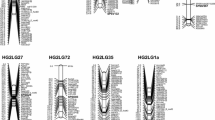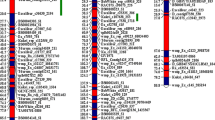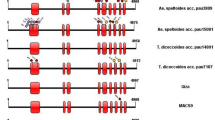Abstract
Sweet sorghum [Sorghum bicolor (L.) Moench] accumulates large amounts of sugars in the stem parenchyma and can be used to manufacture sucrose and alcohol. Soluble acid invertase (SAI) plays an important role in sucrose accumulation in the sweet sorghum stem. Characterization of SAI genes and development of functional markers are important for marker-assisted selection in breeding programs. Here, the full-length genomic DNA sequence of a SAI gene (SAI-1) was cloned by in silico cloning and experimentally validated. The SAI-1 gene comprises three exons and two introns, totaling 4,966 bp, with an open reading frame of 2,025 bp encoding a polypeptide of 674 amino acids. The protein encoded by SAI-1 (molecular weight 73.4 kDa) contains a glycosyl hydrolase family 32 conserved domain, which catalyzes the hydrolysis of sucrose. Four allelic variants at the SAI-1 locus, SAI-1a, SAI-1b, SAI-1c and SAI-1d (GenBank accession nos. JX535515, JX535516, JX535517 and JX535518), were identified in 165 sweet sorghum cultivars. A co-dominant marker, SBX1, was developed to discriminate these variants. The mean Brix value from cultivars with a 141-bp (SAI-1c) PCR product was higher than in cultivars with a 136-bp (SAI-1b) product, and the mean Brix value from cultivars with a 136-bp (SAI-1b) product was significantly higher than those with a 132-bp (SAI-1a) product. The results showed that a domain of ATTGA repeat sequences in the second intron might be an important regulatory site, and that the functional marker SBX1 was closely related to the Brix value, and could therefore be used in sweet sorghum breeding programs.



Similar content being viewed by others
References
Amaducci S, Monti A, Venturi G (2004) Non-structural carbohydrates and fibre components in sweet and fibre sorghum as affected by low and normal input techniques. Ind Crops Prod 20:111–118
Ayres NM, McClung AM, Larkin PD, Bligh HFJ, Jones CA, Park WD (1997) Microsatellites and a single-nucleotide polymorphism differentiate apparent amylose classes in an extended pedigree of US rice germplasm. Theor Appl Genet 94:773–781
Billa E, Koullas DP, Monties B, Koukios EG (1997) Structure and composition of sweet sorghum stalk components. Ind Crops Prod 6:297–302
Calviño M, Messing J (2012) Sweet sorghum as a model system for bioenergy crops. Curr Opin Biotech 23(3):323–329
Daphne M, Arthur AS (1991) Sucrose phosphate synthase, sucrose synthase, and invertase activities in developing fruit of Lycopersicon esculentum Mill and the sucrose accumulating Lycopersicon hirsutum Humb and Bonpl. Plant Physiol 95:623–627
Davies C, Robinson SP (1996) Sugar accumulation in grape berries. Cloning of two putative vacuolar invertase cDNAs and their expression in grapevine tissues. Plant Physiol 111:275–283
Demeke T, Moris CF (2002) Molecular characterization of wheat polyphenol oxidase (PPO). Theor Appl Genet 104:813–818
Ellen MK, Chetelat RT, Alan BB (1993) Expression of acid invertase gene controls sugar composition in tomato (Lycopersicon) fruit. Plant Physiol 103:863–870
Elliott KJ, Butler WO, Dickinson CD, Konno Y, Vedvick TS, Fitzmaurice L, Mirkov TE (1993) Isolation and characterization of fruit vacuolar invertase genes from two tomato species and temporal differences in mRNA levels during fruit ripening. Plant Mol Biol 21(3):515–524
Fedorova L, Fedorov A (2003) Introns in gene evolution. In: Origin and evolution of new gene functions. Springer, Netherlands, pp 123–131
Gnansounou E, Dauriat A, Wyman CE (2005) Refining sweet sorghum to ethanol and sugar: economic trade-offs in the context of North China. Bioresour Technol 96:985–1002
Godt DE, Roitsch T (1997) Regulation and tissue-specific distribution of mRNAs for three extracellular invertase isoenzymes of tomato suggests an important function in establishing and maintaining sink metabolism. Plant Physiol 115(1):273–282
Hadas R, Schaffer A, Miron D, Fogelman M, Granot D (1995) PCR-generated molecular markers for the invertase gene and sucrose accumulation in tomato. Theor Appl Genet 90:1142–1148
Haouazine-Takvorian N, Tymowska-Lalanne Z, Takvorian A, Tregear J, Lejeune B, Lecharny A, Kreis M (1997) Characterization of two members of the Arabidopsis thaliana gene family, Atβfruct3 and Atβfruct4, coding for vacuolar invertases. Gene 197:239–251
He XY, He ZH, Zhang LP, Sun DJ, Morris CF, Fuerst EP, Xia XC (2007) Allelic variation of polyphenol oxidase (PPO) genes located on chromosomes 2A and 2D and development of functional markers for the PPO genes in common wheat. Theor Appl Genet 115(1):47–58
He XY, Zhang YL, He ZH, Wu YP, Xiao YG, Ma CX, Xia XC (2008) Characterization of phytoene synthase 1 gene (Psy1) located on common wheat chromosome 7A and development of a functional marker. Theor Appl Genet 116(2):213–22119
Hubbard NL, Hubber SC, Pharr DM (1989) Sucrose phosphate synthase and acid invertase as determinants of sucrose concentration in developing muskmelon (Cucumis melo L.) fruits. Plant Physiol 91:1527–1534
Jeppe RA, Thomas L (2003) Functional markers in plants. Trends Plant Sci 8(11):554–560
Lingle SE (1987) Sucrose metabolism in the primary culm stem of sweet sorghum during development. Crop Sci 27:1214–1219
Liu HY, Zhu YH (2002) Advances on the studies of invertase on sucrose metabolism in higher plant. Chin Bull Bot 19(6):666–674 (in Chinese with English abstract)
Liu R, Li J, Shen F (2008) Refining bioethanol from stalk juice of sweet sorghum by immobilized yeast fermentation. Renew Energ 33:1130–1135
Liu Y, Zhao XN, Yue MQ, Dun BQ, Zhang BM, Lu M, Li GY (2010) Cloning and characterization analysis of sucrose synthase gene (Susy2) in sweet sorghum (Sorghum bicolor). J Agric Biotechnol 18(1):24–29 (in Chinese with English abstract)
Liu Y, Dun BQ, Zhang BM, Lu M, Li GY (2011) Isolation and characterization of sucrose phosphate synthase gene (sps3-1) in sweet sorghum [Sorghum bicolor (L.) Moench]. Mol Plant Breed 9(3):357–363 (in Chinese with English abstract)
Liu Y, Dun BQ, Zhao XN, Yue MQ, Lu M, Li GY (2013) Correlation analysis between the key enzymes activities and sugar content in sweet sorghum [Sorghum bicolor (L.) Moench] stems at physiological maturity stage. Aust J Crop Sci 7(1):84–92
Lorenz K, Lienhard S, Sturm A (1995) Structural organization and differential expression of carrot beta-fructofuranosidase genes: identification of a gene coding for a flower bud-specific isozyme. Plant Mol Biol 28:189–194
Marchler-Bauer A, Anderson JB, Cherukuri PF et al (2005) CDD: a conserved domain database for protein classification. Nucleic Acids Res 33((Database issue)):D192–D196
Michael DG, Katrien MD (1998) Comparative genetics in the grasses. Proc Natl Acad Sci USA 95:1971–1974
Nesbitt TC, Tanksley SD (2002) Comparative sequencing in the genus Lycopersicon. Implications for the evolution of fruit size in the domestication of cultivated tomatoes. Genetics 162:365–379
Paterson AH, Bowers JE, Bruggmann R et al (2009) The Sorghum bicolor genome and the diversification of grasses. Nature 457:551–556
Rita Z, Konrad S, Uwe S (1996) Soluble acid invertase determines the hexose-to-sucrose ratio in cold-stored potato tubers. Planta 198:246–252
Rosy R, Harsh R, Peter M (2007) Functional gene markers for polyphenol oxidase locus in bread wheat (Triticum aestivum L.). Mol Breed 19:315–328
Shanker S, Salazar RW, Taliercio EW et al (1995) Cloning and characterization of full-length cDNA encoding cell-wall invertase from maize. Plant Physiol 108:873–874
Sturm A, Chrispeels M (1990) cDNA cloning of carrot extra cellular β-fructosidase and its expression in response to wounding and bacterial infection. Plant Cell 2:1107–1119
Thornsberry JM, Goodman MM, Doebley J, Kresovich S, Nielsen D, Buckler ES (2001) Dwarf 8 polymorphisms associate with variation in flowering time. Nat Genet 28:286–289
Yau YY, Simon PW (2003) A 2.5 kb insert eliminates acid soluble invertase isozyme II transcript in carrot (Daucus carota L.) roots, causing high sucrose accumulation. Plant Mol Biol 53:151–162
Yelle S, Chetelat RT, Dorais M (1991) Sink metabolism in tomato fruit IV. Genetic and biochemical analysis of sucrose accumulation. Plant Physiol 95:1026–1035
Zhang W, Dubcovsky J (2008) Association between allelic variation at the Phytoene synthase 1 gene and yellow pigment content in the wheat grain. Theor Appl Genet 116(5):635–645
Zhu YJ, Komor E, Moore PH (1997) Sucrose accumulation in the sugarcane stem is regulated by the difference between the activities of soluble acid invertase and sucrose phosphate synthase. Plant Physiol 115(2):609–616
Zhu YJ, Albert HH, Moore PH (2000) Differential expression of soluble acid invertase genes in the shoots of high-sucrose and low-sucrose species of Saccharum and their hybrids. Funct Plant Biol 27(3):193–199
Acknowledgments
This work was supported in part by the National Sci. and Tech Support Program (2009BADA7B01) and the National Natural Science Foundation (31060036).
Author information
Authors and Affiliations
Corresponding authors
Additional information
Yuandong Nie has equally contributed as the first author.
Electronic supplementary material
Below is the link to the electronic supplementary material.
Rights and permissions
About this article
Cite this article
Liu, Y., Nie, YD., Han, FX. et al. Allelic variation of a soluble acid invertase gene (SAI-1) and development of a functional marker in sweet sorghum [Sorghum bicolor (L.) Moench]. Mol Breeding 33, 721–730 (2014). https://doi.org/10.1007/s11032-013-9988-8
Received:
Accepted:
Published:
Issue Date:
DOI: https://doi.org/10.1007/s11032-013-9988-8




